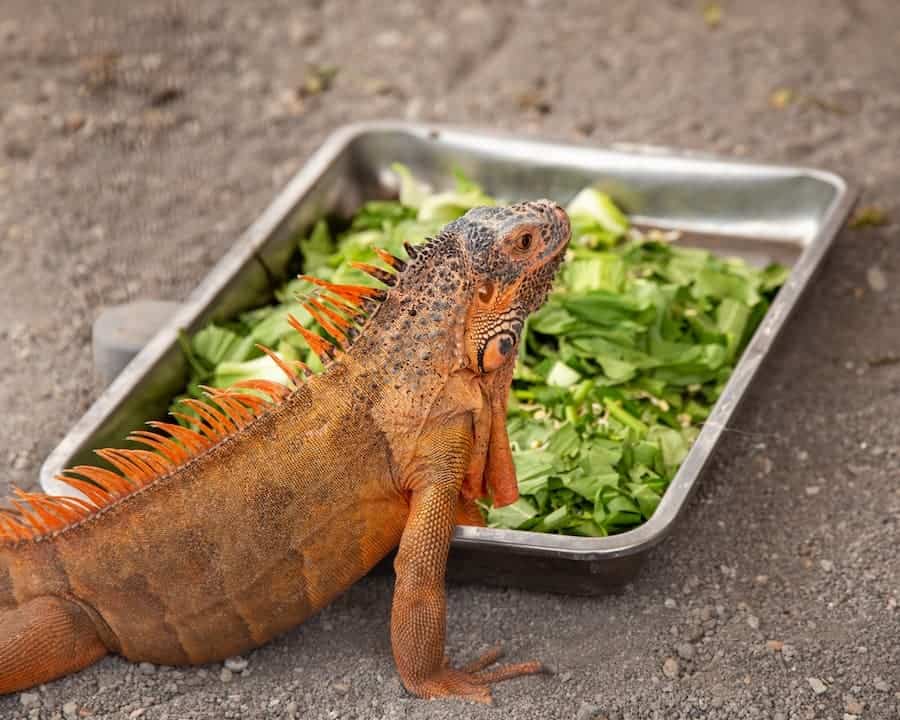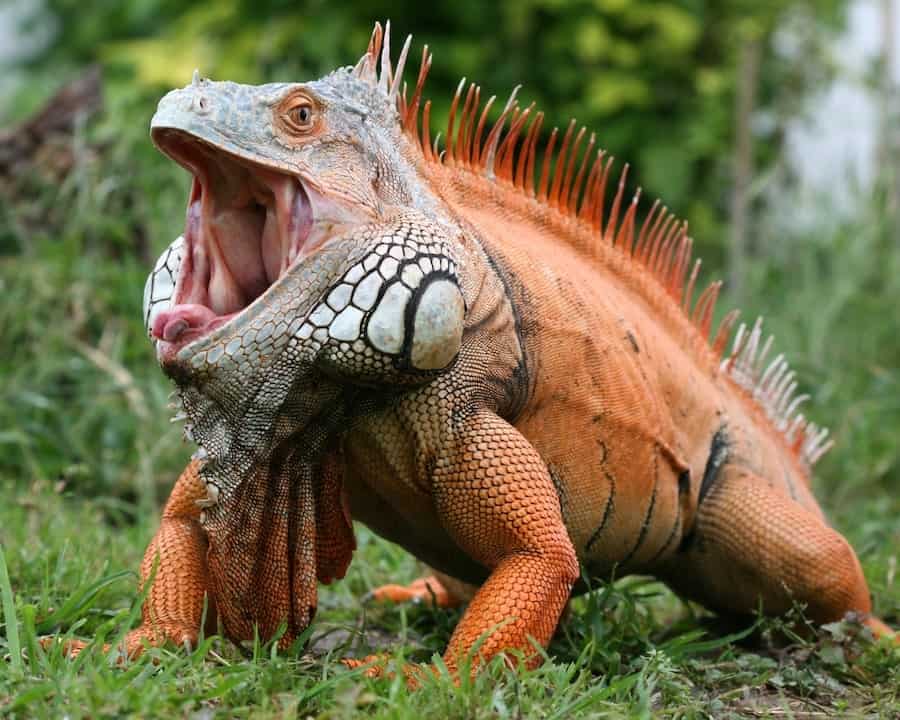You may have been completely puzzled at the peculiar site of an iguana bobbing its head, as it’s not a common site among other lizards. If you happen to own a pet iguana, it’s crucial that you learn how to interpret the different types of bobbing, especially if you’d like to avoid a trip to the ER!
The following are the most common reasons why all iguanas bob their heads:
Friend or Foe Head Bobbing
For simplicity’s sake, I’d like to note that head bobbing is usually the cause of the iguana feeling upset, or in less common cases, a type of hello.
When an iguana is feeling upset, the head bobbing is more intense compared to a greeting, and more than likely combined with the following signs of aggression:
- Inflated dewlap
- Turning sideways to give the appearance of a bigger iguana
- Hissing
- Stiff tail ready to whip
- Wide open eyes
1 Display of Territorial Ownership
Most males in the animal kingdom display some sort of aggressive territorial behavior towards members of the same species, and in many cases, different species as well. Iguanas are no exception.
However, territorial bobs are not confined to only males, as juveniles and females have also been known do the same.
Should you intrude into a space which the iguana has claimed as its own, you may experience what iguana expert James Hatfield describes in his book, “Green Iguana The Ultimate Owner’s Manual,” as the “signature” bob.
This specific head bob involves the iguana dipping its head real low followed by an abrupt ascend combined with a pause, and multiple vertical bobs of reduced amplitude.
The next logical and wise step would be for you to give the iguana its space, and possibly avoid an injury.
Are iguanas overall dangerous creatures? Check out this post I wrote titled, Are Iguanas Dangerous? Not Your Average Pet.
2 Display of Food Ownership

No one likes to have their food taken away, especially not iguanas.
Therefore, it’s not at all uncommon for an iguana to bob its head at you if it feels like its food is on the line.
Be extra wary right after feeding your iguana, as this is when he or she is more likely to bob their heads in a display of aggression.
3 Simply Having a Bad Day

People aren’t the only ones that experience random mood swings.
An iguana’s mood can change according to hormonal changes and other physiological functions, thus making them more aggressive than usual, and triggering their notorious head bobbing.
4 Mate Ownership

It’s imperative that you know which months constitute mating season, as that is when iguanas can be very aggressive, and the aggression displayed as a head bobbing ritual.
Wild iguanas enter mating season once a year in October and peak around January and February.
However, in captivity, owners have claimed their male iguanas are still breeding as late as the summer, and sometimes twice a year.
It makes sense if you think about it. If an iguana has more “recreational” time then it doesn’t have to worry about staying alive nearly as much as its feral counterparts, but I digress.
Although mature males bob their heads more frequently than females during mating season, it’s not uncommon for females to do the same. However, males do it to attract females and ward off other males.
Head bobbing during mating season is a form of aggression. Therefore, if you get too close, be on guard for a tail whip or bite.
5 Status in The Social Hierarchy

A more neutral head bob (with regard to aggression) is the one used to establish the pecking order in the iguana social hierarchy.
This type of head bob is usually slower, and the iguana has a relaxed, almost bored look on its face.
Interestingly enough, when a dominant iguana in the wild bobs its head in this style, the less dominant male iguanas are more likely to bob their heads like a female.
So as long as the iguana is not displaying additional forms of aggression, it’s perfectly okay to continue petting him or her.
According to iguana researcher John A. Phillips, “conspicuous advertisement of social status is common in natural populations, with large, dominant males displaying about 5 times more frequently than smaller, subordinate individuals.
6 Greeting Sign

A relatively positive head bob, which is very similar to the neutral social hierarchy bob, is the iguana’s “what’s up” nod.
This is an iguanas way of simply saying, “hello there, I see you and acknowledge your presence.”
Iguanas will greet not only other iguanas, but animals and people as well. If done correctly, you can nod back.
However, I emphasize “correctly,” because if done incorrectly, your nods may be interpreted as aggression by your iguana, and now you have a very angry iguana. Yes, I tell you from experience.
7 Warning To Other Animals

Iguanas have a very specific head bob that is mostly used to warn off other iguanas which they deem to be a threat.
This nod involves the shaking of the head in a sideways and very rapid motion, almost like a wet dog after a bath.
If the subservient iguana refuses to retreat after this type of warning, it can expect a chase and possibly even a fight.
Are you worried about your dog’s safety after adopting an iguana? Check out this post I wrote titled, Can Iguanas Hurt Dogs? Keep Your Furry Friends Safe.
Do All Iguanas Bob Their Heads?
Yes, all iguanas, from hatchlings to mature males and females, bob their heads.
They may do it for different reasons, but they all do it nonetheless, which is why head bobbing is not a good indicator for identifying genders.
However, to quote James Hatfield again, “for iguanas in the wild, particularly males, head bobbing gets more frequent and pronounced as the iguana gets bigger and more dominant.”
Juveniles tend to have their very own specific style of head bobbing, but the intention is the same.
Additionally, individual iguanas will all vary with regard to how often they they bob their heads, kind of like how we as people have our unique character.
Male vs Female Head Bobbing
As previously mentioned, male and female iguanas both bob their heads.
According to anapsid.org, males bob their heads in a much more fluid and smoother motion, with a few specific bobs involving sideways movements.
Males also bob their heads more frequently than females.
When females bob their heads, they include rapid and jerky movements, almost as if they’re learning how to bob their heads.
What to do When An Iguana Bobs Its Head
Unless you’re very adept at identifying different types of iguana nods and behaviors I would stay clear of any feral iguanas which bob their head at you.
More than likely the iguana is displaying aggression, thus increasing your chances of an injury.
If your pet iguana bobs its head at you, give them his or her space before re-attempting to get near, and just as importantly, learn to identify whether your iguana is displaying signs of aggression or simply greeting you.
If your iguana is greeting you, it’s okay to continue petting and/or handling your lizard.
After reading this post, I think we can both agree it would be a great idea to be able to identify the signs of an angry iguana. Luckily, I wrote a post on exactly that topic, and it’s titled: 7 Signs An Iguana is Mad: Ignore At Your Peril.

